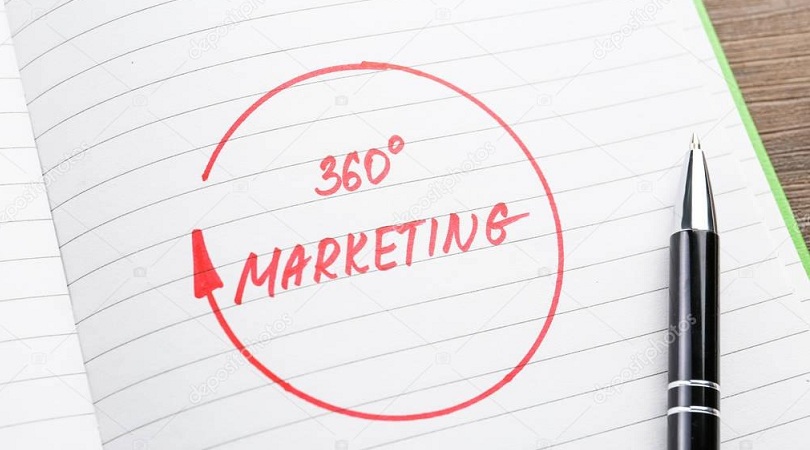A 360-Degree Marketing Strategy is a method of making sure your brand is everywhere… and in everything, but it can be so innocuous that you may not even realize that you’ve experienced the marketing message. That’s the level of influence an interconnected, cohesive, and wide-spread marketing presence can offer. Let’s talk about how it works.
What is 360-Degree Marketing?
The 360-Degree Marketing approach requires a comprehensive analysis of your customers, so you can leverage that information and details to your best advantage in addressing their needs and concerns. At its best, 360-Degree Marketing takes a holistic, end-to-end, inclusive approach to cultivating your brand and approaching your ideal customers and target market. It is designed to offer the best possible route to the customer’s brand journey and experience, regardless of whether they are a fresh new lead, in the exploration stages, or ready to convert.
With 360-Marketing, you can see the customer’s past purchases, interactions, and process history. You can also see the present status of the customers, including a current status of order, interactions, and relationships with your organization. When you understand the importance of the past and present to your Marketing 360 campaign, you’ll begin to see the power of digital intelligence to fill your lead generation pipeline. You’ll also see how 360 can effectively convert your prospects into clients, seamlessly. To understand how it all works, though, you must first understand the key components that make up 360 marketing. Here’s an overview.
What are the Key Components of 360-Degree Marketing?
Your goal with 360-Marketing strategies is to create campaigns that will not only reach your prospects, but be compelling and positively received, so that you can convert your prospects into clients, buyers, patients or customers. There’s no one perfect formula or set of key components that will guarantee you a successful marketing campaign. Nevertheless, here are key components that are the building blocks to success.
Effective Website
Some 88% of consumers will conduct online research before they commit to buying a product or service, according to the eCommerce Foundation. That’s a huge part of why it’s so important for you to have an effective website, but there’s more to it than that. When your prospects conduct their research and find your website, it’s their first impression of what you have to offer. So, you must keep these tips in mind:

• Your website should be stellar. The first response should be, “Wow… this is the business I want to work with”.
• Your website should be fast, reliable, and easy to use.
• It should appear professional, both in how it’s designed but also with professional content.
• Your website should enhance your credibility and help sell you as an expert in your field.
A well-designed website should be your best “salesperson”. So, once the web visitor says “Wow!”… they will proceed to be led through an engaging journey. Each step of the way should progress seamlessly, so the visitor is 100% clear on what you do and how you do it. It’s really the perfect platform to exact the ideal sales presentation. From “greeting” to “closing”, and every step in between, your website should educate, dispel objections and clearly define in the visitor’s view that your business or practice is their choice to do business with. Websites are not always the easiest platforms to pull off, particularly because of the technical requirements involved in designing and launching an effective website. Effective websites are a powerful tool for connecting with your audience and building your brand.

Search Engine Optimization (SEO) Strategy
Search Engine Optimization (SEO) Strategy is the next step beyond launching your effective website, and it builds on that first essential step of a well-designed website. SEO strategy centers around activities that will help to catapult your site in the search engine rankings. Here are a few top tips:
• Write content for people…your target audience, not computers.
• Publish well-crafted content on a consistent basis. This can be in the form of on-page content, blogs, white-papers, press releases, and other engaging information.
• Implement web analytics, so you can track results and return-on-investment (ROI).
• Use keywords, but only when it makes sense.
Your website won’t be completely perfect, and neither will your SEO Strategy, but you must do your best to create and optimize content, and also to continue to develop resources that will continue to draw more prospects and distinguish your business as the “authority” and the most attractive to do business with.
Pay-Per-Click (PPC) Advertising
Like SEO, Pay-Per-Click (PPC) Advertising drives traffic to your site, but it’s different in that you’re paying for the results. That can mean you can see more immediate upticks in your traffic and lead generation, but it’s important that you take a strategic approach. Here are a few tips:
• Create landing pages to better address the needs of those targeted leads, while collecting them into your sales funnel.
• Carefully target geographical locations, times-of-day, and keywords to get the best results possible.
• Rotate your ads and campaign messaging, while tracking which ones deliver the best ROI.
PPC can be a complicated affair, fraught with continual adjustment and optimization, but it can drive traffic to your site and deliver the conversions you need. While PPC Advertising should hold a piece of your marketing budget, don’t put all your eggs in one basket. This is just one of the many components to your effective 360-Degree Marketing, and we’re here to walk you through the entire process.

Email Marketing
Email marketing really is the next, best way to nurture your leads until they become clients. It’s fast, easy, and relatively painless to set up auto-responders to immediately begin marketing to your prospects via email, but your growing list is also the perfect platform for continued check-ins, deals, news, and features. Here are a few tips.
• Be consistent with your email marketing to connect with your audience and build your brand.
• Make sure your email marketing message has the right “voice.”
• Continue to spark their interest with real and compelling news and promotions.
• Remember this is a professional platform for communication. Make sure every email, auto-responder message, and newsletter are tested and as perfect as possible.

Your email marketing can be as simplified or as complex as you want or need it to be. You can build segmented lists, target specific messages to certain demographics, or just go with the mass messaging approach. Listen to your customers and develop email marketing strategies that will best meet their needs. Evans Alliance has developed one of the timeliest, cost effective and accurate forms of marketing and measurable outreach. We call it “STEM™ – Strategic Targeted Email Marketing”. By delivering a series of carefully crafted email messages directly to a select target audience, we introduce a Client’s products to qualified prospective buyers, patients, partners or alliances.
Social Media Marketing
Social media is so commonplace that it doesn’t even feel like marketing anymore, and that’s a good thing. When you use social media marketing as part of your 360-Degree Marketing, you want those posts and ads to engage with customers in a way that feels “organic” and real. You need to connect with your audience, build relationships, build your brand, and show there’s a “real” you behind the scenes. Here are some tips:
• Be sure that you understand who your audience is, what they need, and how you can best help them or provide a solution.
• Don’t try to be all things to all platforms. Focus on the platforms where your customers “live.”
• Set goals, determine to message, and then deliver on that promise in a consistent manner.
Social media marketing is a fun and effective way to organically engage with your audience and grow your customer base, but it’s not for the faint of heart. It requires careful strategy and the ideal situation would be for you to work with a dedicated person or group, who delivers the consistency, reliability, and clarity of content you will need for your social media marketing to be effective.
What about “Offline” Marketing?
No, offline marketing or traditional marketing is not dead. And, yes, it can still be a vital part of your business’ marketing mix. With so many other online platforms and strategic approaches, it’s often easy to forget that there still are those tried and true methods of lead generation and conversion. Let’s see, there are the billboard, radio spots, TV ads, printed flyers, brochures and other collateral, direct mail, in-person/store events, free or paid seminars, newspaper/print ads, and so much more.
The fact that these are not usually top of mind these days can mean that they could be the perfect way to mix up your 360-Degree Marketing Strategy. Don’t be afraid to try something new, even if the “new” is actually an approach that has been around for a long time. Just remember to track your results, and determine how effective those more traditional approaches were, compared with online methods. Remember, Evans Alliance is here to help you implement you successful 360-Degree Marketing Strategy.
Call 973-250-4040 to Schedule Your Consultation – Learn More About Our Targeted Approach.


